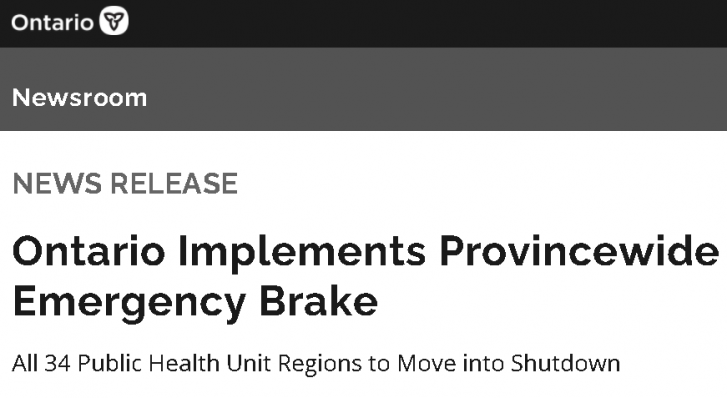This post is also available in: 简体中文 繁體中文
All 34 Public Health Unit Regions to Move into Shutdown
TORONTO —The Ontario government, in consultation with the Chief Medical Officer of Health and other health experts, is imposing a provincewide emergency brake as a result of an alarming surge in case numbers and COVID-19 hospitalizations across the province. The provincewide emergency brake will be effective Saturday, April 3, 2021, at 12:01 a.m. and the government intends to keep this in place for at least four weeks.
Details were provided today by Premier Doug Ford, Christine Elliott, Deputy Premier and Minister of Health, Dr. David Williams, Chief Medical Officer of Health, and Dr. Adalsteinn (Steini) Brown, Co-Chair of the Ontario COVID-19 Science Advisory Table.

“We are facing a serious situation and drastic measures are required to contain the rapid spread of the virus, especially the new variants of concern,” said Premier Ford. “I know pulling the emergency brake will be difficult on many people across the province, but we must try and prevent more people from getting infected and overwhelming our hospitals. Our vaccine rollout is steadily increasing, and I encourage everyone who is eligible to get vaccinated. That is our best protection against this deadly virus.”
Ontario’s key indicators and latest modelling show that additional measures must be taken. From March 26 to 28, 2021, provincial case rates have increased by 7.7 per cent to 101.1 cases per 100,000 people. Current COVID-19 related ICU admissions are already over the peak of wave two and hospitals in regional hotspots will need to further ramp down scheduled surgeries. COVID-19 related ICU admissions are projected to exceed 650 beds in a few weeks. These increases are being driven by COVID-19 variants, which are transmitted easily and result in a higher risk of death and hospitalization, including in younger populations.
The provincewide emergency brake would put in place time-limited public health and workplace safety measures to help to stop the rapid transmission of COVID-19 variants in communities, protect hospital capacity and save lives. Measures include, but are not limited to:
- Prohibiting indoor organized public events and social gatherings and limiting the capacity for outdoor organized public events or social gatherings to a 5-person maximum, except for gatherings with members of the same household (the people you live with) or gatherings of members of one household and one other person from another household who lives alone.
- Restricting in-person shopping in all retail settings, including a 50 per cent capacity limit for supermarkets, grocery stores, convenience stores, indoor farmers’ markets, other stores that primarily sell food and pharmacies, and 25 per cent for all other retail including big box stores, along with other public health and workplace safety measures;
- Prohibiting personal care services;
- Prohibiting indoor and outdoor dining. Restaurants, bars and other food or drink establishments will be permitted to operate by take-out, drive-through, and delivery only;
- Prohibiting the use of facilities for indoor or outdoor sports and recreational fitness (e.g., gyms) with very limited exceptions;
- Requiring day camps to close; and,
- Limiting capacity at weddings, funerals, and religious services, rites or ceremonies to 15 per cent occupancy per room indoors, and to the number of individuals that can maintain two metres of physical distance outdoors. This does not include social gatherings associated with these services such as receptions, which are not permitted indoors and are limited to five people outdoors.
On the advice of the Chief Medical Officer of Health, all Ontarians are asked to limit trips outside the home to necessities such as food, medication, medical appointments, supporting vulnerable community members, or exercising outdoors with members of their household. Employers in all industries should make every effort to allow employees to work from home.
“Ontario, like many other provinces and jurisdictions around the world, is in the third wave of the COVID-19 pandemic and immediate action is required to help turn the tide,” said Christine Elliott, Deputy Premier and Minister of Health. “Implementing a provincewide emergency brake was not an easy decision to make and is not one we take lightly. As we continue to vaccinate more Ontarians, the end is in sight, but right now these necessary measures will help to stop the spread of variants in our communities, protect capacity in our health care system, and save lives.”
The current COVID-19 Response Framework: Keeping Ontario Safe and Open, will be paused when the provincewide emergency brake comes into effect. The impacts of these time-limited measures will be evaluated throughout the next four weeks to determine if it is safe to lift any restrictions or if they need to be extended. With more than $1.6 billion invested to protect against COVID-19, schools remain safe for students and staff. Keeping schools open is critical to the mental health and well-being of Ontario youth. During the emergency shutdown, schools will remain open for in-person learning with strict safety measures in place. The spring break will continue as planned for the week of April 12. In order to support working families, child care will remain open during the shutdown. Child care settings will continue to adhere to stringent health and safety measures so that they remain safe places for children and staff.
“In the last few weeks a significant increase in COVID-19 cases and variants of concern has been observed across Ontario which has put considerable strain on our public health and health care systems,” said Dr. David Williams, Chief Medical Officer of Health. “Implementing a provincewide shutdown is needed to bring the third wave of this pandemic under control so that we can save lives, keep our education system open and allow our vaccination program to take hold.”
Article From: The Government of Ontario Website

